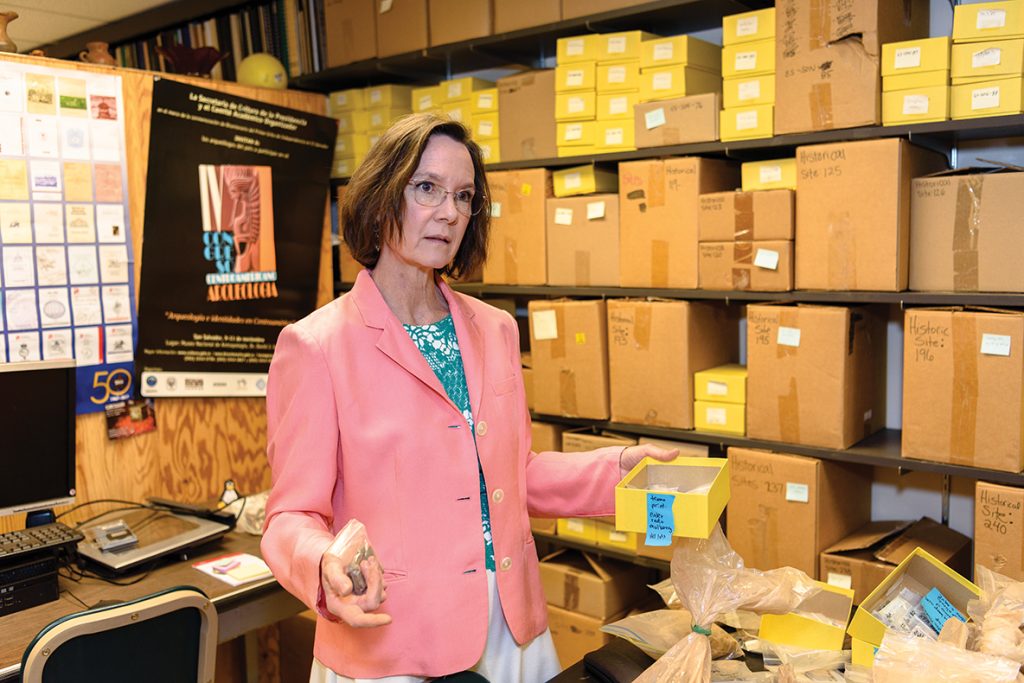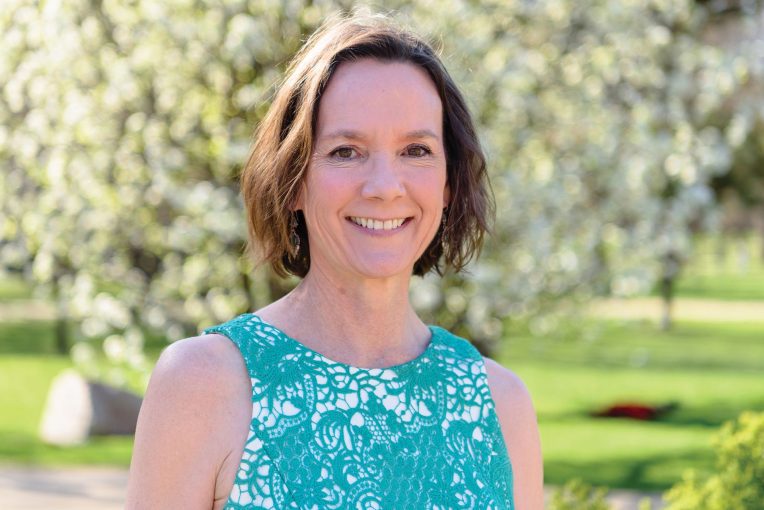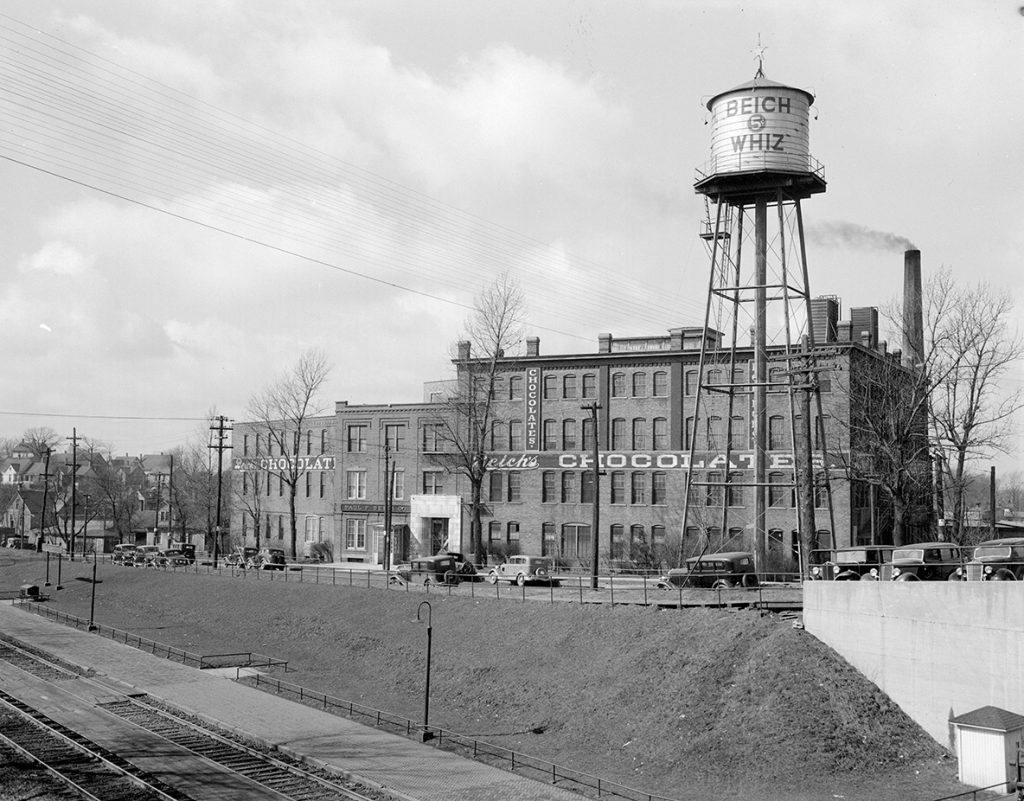Dr. Kathryn Sampeck’s research focuses on a sweet subject with a not-so-sweet history.
The Illinois State University professor of anthropology studies the cultural, economic, environmental, and social impacts of chocolate. Her research recently earned her a prestigious British Academy Global Professorship, and with it, an award of over $1 million. She and a group of scholars at the University of Reading will spend the next four years advancing our understanding of one of the Western world’s favorite treats.
Appears InFew consumers consider the complicated history of chocolate—a centuries-old power struggle over a commodity that became currency in some places—as they seek their next chocolate fix.
But Sampeck does, and she wants to understand it even better.
“Four years really gives me time to develop connections with other people,” Sampeck said. “It’s sometimes tedious work that takes a long time—whether it’s digital development or looking at pottery sherds, it takes a long time. This is very meticulous work.”
Sampeck has been living in England since January. Her team has access to the British Museum’s archives and its state-of-the-art archaeological laboratories for performing chemical analyses of ancient food remains. The team is conducting residue studies of pottery and tools that are hundreds—sometimes thousands—of years old.
“It’s what everyday people used in their homes,” Sampeck explained. “There are traces we can recover that will help us get a holistic understanding of chocolate, of when it emerges, and how it changes.”
“People were literally buying things with cacao seeds. Cacao was circulating as currency in Mexico, Guatemala, and Nicaragua.”
—Dr. Kathryn Sampeck
The University of Reading is the perfect place to undertake research on chocolate as it is home to the International Cocoa Quarantine Centre. Since the 1980s, the university has gained a global reputation for cocoa research.
An archaeologist by training, Sampeck had been searching for an interesting research project when she became curious about chocolate and its global obsession. Her interest was initially sparked in the mid-1990s when she went to El Salvador to conduct graduate fieldwork.
“Chocolate is made from the seeds of a tropical tree called cacao, and that region of western El Salvador—not much archaeological research had been done there—is special because it’s the origin place of chocolate,” Sampeck said. “People in Mexico and Central America grew cacao and used it to make lots of other different kinds of foods and drinks with different names and flavors, while the local specialty in this region was chocolate.
“The first domestication of cacao probably happened in northern Amazonia, and then 3,500 to 4,000 years ago, it reached Mexico and Central America. From there, it blossomed and became part of cultures in feasts and ceremonies.”
Sampeck, who has earned three Fulbright scholarships and received funding from the National Science Foundation, has been at Illinois State since 2008. Her specialties include archaeology, the anthropology of food, and Latin American studies. She is interested in how people have evolved to present day but also how they connect to the past.
“I’m a historical archaeologist, so I use different lines of evidence, including ceramics, broken pottery, stone tools, historical documents of all kinds,” she said. “I even work with contemporary people to understand the historical path.”
Sampeck’s current research seeks knowledge of the different ways people used cacao. What’s certain is that its popularity quickly soared—so much so that it was even used as currency.
“People were literally buying things with cacao seeds,” Sampeck said. “Cacao was circulating as currency in Mexico, Guatemala, and Nicaragua. Money literally grew on trees, so the colonial market became more interested in cacao.”
At the same time, Spain was experiencing a currency crunch. The evidence is clear, Sampeck said, that countries seeking fortunes brought invaders to the region. “The Spanish wanted to get their hands on this ‘money,’” she said.

Sampeck described the story of chocolate during its colonial phase as a time of tremendous violence against Indigenous people. Despite the violence, disease, and pressure to produce cacao, the communities in El Salvador were incredibly resilient and reached astounding production rates.
Salvadorans’ resilience was further tested in the 1600s when Spain tried to take cacao from Indigenous people by using enslaved African labor.
By the 18th century, most production had expanded and moved to Africa. Today, about 95% of cacao comes from West Africa for name-brand chocolate, but labor conditions remain a concern.
According to Sampeck, the globalization of chocolate has caused deeper inequalities, with 75% of chocolate consumption taking place in Europe, the United States, and Canada, while nearly all chocolate is produced, mostly by hand, by people of color. She estimates the industry is the source of livelihood for up to 50 million people, most of them living in developing countries.
But Sampeck sees some reason to be hopeful. “There’s been a positive development in the last five to 10 years,” she said. “Now it’s much more common for consumers to know where the cacao is coming from. It’s a chance for the consumer to be informed.”
When Sampeck learned last year that she had been awarded the professorship to further her research, it caught her by surprise. The Illinois State professor described her reaction as something akin to Sally Field fumbling through an Oscar acceptance speech by trying to thank everyone she’d ever met. “I was just really overwhelmed, just in disbelief,” Sampeck said.
Support from her family and her Illinois State colleagues and friends has meant the most, she said. Illinois State’s Department of Anthropology and Sociology has been especially supportive.
“This fellowship only serves to further demonstrate Dr. Sampeck’s role as a seminal scholar and dedicated teacher,” said Dr. Joan Brehm, chair of the department. “ISU is exceptionally fortunate to have such a leading-edge scholar working with us and our students.”
Lending a key faculty member like Sampeck to an institution in England for four years presents a challenge in the near term, Brehm said, but it’s a challenge outweighed by the benefit to the University and its future students.
“We never hesitated to find a way to support her in this amazing opportunity,” Brehm said. “ISU provided tremendous support and guidance to help us find the mechanisms to make this possible, while ensuring we retained our strong commitment to our students to minimize any impact on them during her absence.
“In the end, this experience will greatly benefit not only Dr. Sampeck, but also our students as they will have the opportunity to work with and learn from her upon her return.”
Local Flavor: The rich history of chocolate in Bloomington-Normal
Local flavor
When she returns from a global professorship, Dr. Kathryn Sampeck will shift her attention to a local subject: the rich history of chocolate in Bloomington-Normal.
The Twin Cities were home to chocolate enterprise even before Illinois State University’s founding. It began around 1854 with J.L. Green, who sold cigars, firecrackers, and occasionally candies and chocolates (with no refrigeration, the latter items were only available during cooler months). Green’s business was purchased by Paul F. Beich, who had worked there as a teen, and Otto Buffe. The partners began operations in Downtown Bloomington and later persuaded famed chocolatier Milton Hershey to relocate his Lancaster Carmel Co. from Chicago to a vacant factory at the corner of Front and Lumber streets. Beich eventually bought out Hershey and Buffe and renamed the business the Paul F. Beich Candy Co.
Beich helmed the candy dynasty that produced iconic treats Laffy Taffy, Katydids, and Golden Crumbles in the Bloomington factories. Later led by Beich’s descendants, the company even produced nutritional survival bars distributed to soldiers and astronauts. Many locals fondly recall elementary school field trips to a factory on Bloomington’s southwest side opened in the late 1960s, often leaving with bags of cracked or otherwise imperfect chocolates unfit for sale.
The company was sold to Nestle in 1984. Nestle sold its business to Ferrero in 2018. Ferrero still produces chocolate and candy at the southwest Bloomington factory and in 2022 broke ground on a $214 million facility that will expand its local footprint.
Sampeck’s future research will seek clarity on the timeline of local chocolate production, the source of its cacao, and its workforce demographics.


